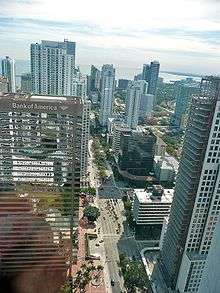Brickell Avenue
Brickell Avenue is a north–south road that is part of U.S. Route 1, in Miami, Florida, just south of the Miami River.[3] North of the Brickell Avenue Bridge, U.S. Route 1 is known as Biscayne Boulevard. Brickell Avenue is the main road through the Brickell financial district of Downtown Miami and is considered "Wall Street South." Brickell Avenue is lined with high-rise office buildings and residential condominiums, as well as many banks and restaurants. It is also famed for "Millionaire Row's" home to a cluster of Miami's most expensive residences.
| |
|---|---|
| Route information | |
| Length | 1.8 mi[1] (2.9 km) |
| Existed | 1898[2]–present |
| Major junctions | |
| South end | |
| North end | |
| Location | |
| Counties | Miami-Dade |
| Highway system | |
It is a grid plan main north–south thoroughfare through the south part of Miami's central business district.
Route description

Brickell Avenue from the Miami River south it continues south-southwest and upon crossing Broadway/SE 15th Street it curves southwest and continues in that direction until it terminates at Southeast 26th Road/Rickenbacker Causeway, becoming South Federal Highway for a short distance (about 1/4 mile) until it becomes South Dixie Highway - US1. The portion north of the one-way pair of 7th and 8th Streets carries U.S. Route 41.
Notable attractions on Brickell Avenue
Brickell's cultural significance has arguably surpassed downtown because its bar and restaurant zone brings in large crowds well into late night - early morning hours. Popular restaurants on Brickell Avenue include Komodo, La Petit Maison, Truluck's, and Cipriani.
Many of the restaurants on Brickell Ave transform from bright, open restaurants during the day to inviting and sensual by night. Some of the places include Barsecco, Baby Jane Cocktail & Noodle Bar, and The Bar at Level 25.
There are also a few historic places on Brickell Ave such as Brickell Mausoleum and Villa Serena, a home built on the former "Millioniare's Mile" for William Jennings Bryan, a former politician in 1913.

Demographics
Based on the 2010 U.S. Census, Brickell's racial makeup was 62.0% Hispanic of any race, 33.2% White (non-Hispanic), 1.6% Asian, and 1.4% Black. The population of Brickell in 2010 had 27,776 people, with a population density of 37,622 per square mile.
A large amount of Brickell's population works in banking, law, and finance. Of Brickell's population, 36% have a master's degree or higher and 38% have a bachelor's degree.
Major intersections
The entire route is in Miami, Miami-Dade County.
| mi[1] | km | Destinations | Notes | ||
|---|---|---|---|---|---|
| 0.0 | 0.0 | Access to tolled Rickenbacker Causeway via SR 913 east | |||
| 1.1 | 1.8 | Eastern terminus of SR 972 | |||
| 1.5 | 2.4 | Eastern terminus of US 41 | |||
| 1.7 | 2.7 | Brickell Avenue Bridge over the Miami River | |||
| 1.8 | 2.9 | ||||
| 1.000 mi = 1.609 km; 1.000 km = 0.621 mi | |||||
Gallery
 Aerial view of Brickell Avenue, as seen from the Viceroy Tower's skydeck.
Aerial view of Brickell Avenue, as seen from the Viceroy Tower's skydeck. Looking south
Looking south- Looking north
 South end of Brickell Avenue
South end of Brickell Avenue
References
- Google (January 1, 2020). "Brickell Avenue" (Map). Google Maps. Google. Retrieved January 1, 2020.
- Arva Moore Parks; Sarah E. Eaton (June 17, 1997). George E. Nolan House, 1548 Brickell Avenue: Designation Report (PDF) (Report). City of Miami. p. 7. Archived from the original (PDF) on July 14, 2010. Retrieved November 18, 2012.
By the time the railroad arrived in 1896, spurred in part by the Brickells’ gift of land to Henry Flagler, the Brickells had already paved a rock road, known as the Coconut Grove Trail, through their property. In 1898, the trail became a 145 foot wide roadway called Brickell Avenue and extended from the Miami River to Broadway (15th Road).
- "Brickell Avenue Neighborhood Guide". Archived from the original on February 6, 2010. Retrieved February 4, 2010.
